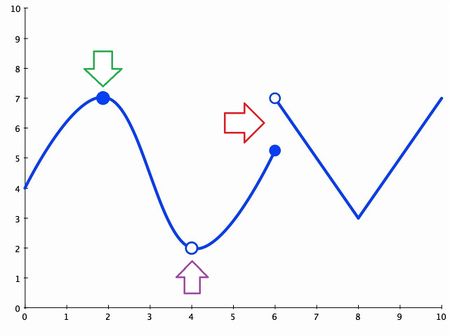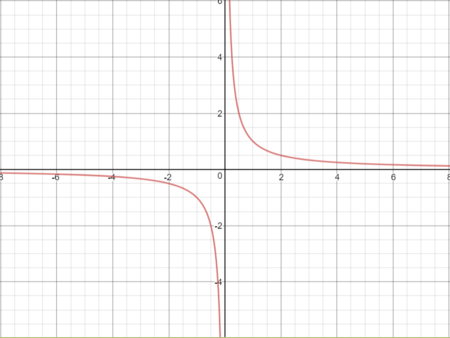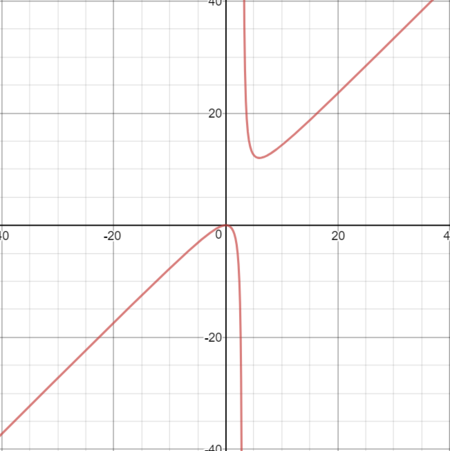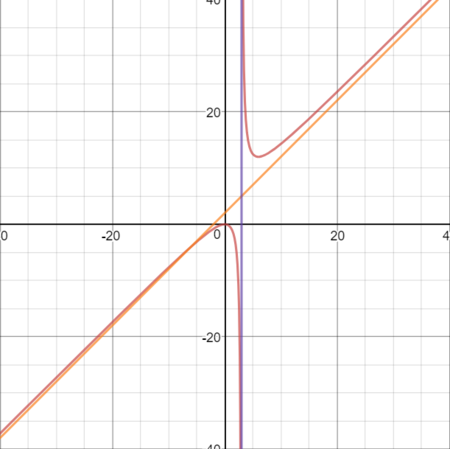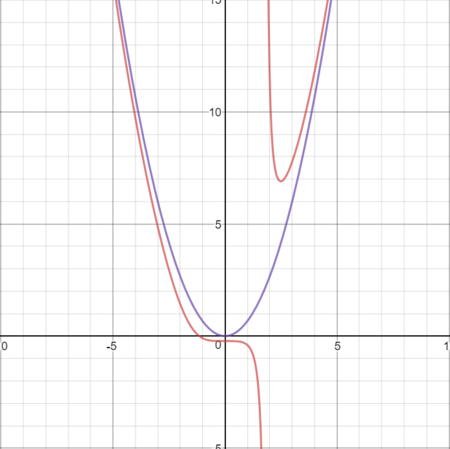Limits Approaching Infinity Conceptually
by Kevin LaMaster, proud Member of the Math Squad.
Contents
[hide]Introduction
I've noticed that many calculus one students loathe taking limits specifically as they approach infinity. This series should not be an introduction to limits nor should it replace a strict definition for a limit. Both of those can be found better at this tutorial. This only serves for a crash course tutor replacement for Calculus 1 students struggling with some difficult homework. If you wish you could solve limits like
$ \lim_{x\to\infty}sin(\frac{x^4-sqrt(2)x^2+e^{\pi}x}{x^{25}+x(x+2)(x-1)}) $
then stick around Or skip to the end. I'm a introduction not a cop
Basic Limits
Just as a recap over basic limits not into infinity.
Limits of Continuous functions
For the majority of limits the limit can just be found by plugging the values into the function.
Unfortunately the only limits most people are interested in are not these easy ones
For example $ \lim_{x\to 2}x^2+2x+1=2(2)^2+2(2)+1 $
The definition of a continuous function is that the limit at any point is equal to the value at that point.
The complicated math way to say this is $ \lim{x\to x_0}f(x)=f(x_0) $
This makes sense. If a function is continuous then every point is exactly where we would "expect it to be".
As you can see by the graph, the green arrow shows a point on the graph that is exactly where we would expect it to be. The graph is continuous at this point.
The purple arrow shows a place where we would expect a point, but there isn't one there. The graph isn't continuous at that point.
The red arrow shows a point where we don't know what to expect. Coming from the left it looks like the graph should be the lower point. But coming from the right we would expect it to be the higher point. Since the function can't do both it isn't continuous at this point. This topic of approaching a limit from one direction or another brings us to our next topic.
Directional Limits
In the case of the graph above we may want to know the limit as we approach a point strictly from the left or from the right. We show this in our limit with a small plus or minus sign floating above the value.
For example. $ \lim_{x\to 2^{-}}2x+1=5 $. Notice that just because its $ 2^{-} $ DOES NOT make it the same as $ -2 $. This means we take the limit as we approach the point 2 from numbers slightly less than 2. The same is true in reverse for $ 2^{+} $
Dividing by Zero and Infinity??
To set the record straight before we begin, infinity does not work like any other run of the mill number. It is, specifically by definition, not a number. A quick example of why not would be
$ \infty + 3=\infty\\ \infty - \infty + 3 =\infty - \infty\\ 3=0 $
As I'm sure you all have experienced, divide by zero errors are the bane of any mathematician. Lets try to find if there is a way to get close but not quite zero and see what that is. What better way to do this than with our new found tool. The limit.
Lets see what happens if we do $ \lim_{x\to 0}\frac{1}{x} $
We can't just plug it in like before and there's nothing we can cancel it out with, so lets just get closer and closer by hand.
If we try the following values:
| x | $ \frac{1}{x} $ |
|---|---|
| .1 | 10 |
| .001 | 1000 |
| .000001 | 1000000 |
This seems pretty pointless, the smaller the number we put in the bigger the number we get out seemingly without end. Let's just make a name for this concept of a value without an highest bound and call it fibigy or better yet infinity. (Note that we are not saying that infinity is this number but rather a concept for a value without anything higher than it)
Now that we've made this "new" term, $ \infty $, we can say that $ \lim_{x\to 0}\frac{1}{x}=\infty $**
We can try a similar process in reverse with this new found term infinity
I wonder what $ \lim_{x\to\infty}\frac{1}{x} $ is?
What if we try the same method as before?
| x | $ \frac{1}{x} $ |
|---|---|
| 10 | .1 |
| 1000 | .001 |
| 1000000 | .000001 |
We know for sure that this value can never be negative since the numbers only get larger positive, and we know that the numbers will never stop getting lower.
Combined we can pick the smallest not negative number we can find, 0.
This makes sense $ \lim_{x\to\infty}\frac{1}{x}=0 $ and $ \lim_{x\to 0}\frac{1}{x}=\infty $**
Now we can apply these two limits to problems that look much more difficult than they are.
CAUTION
- We cannot say that $ \frac{1}{0}=\infty $ for similar reasons to why we cannot use infinity as a number
- For example $ 1*\frac{1}{0}=\infty=\frac{2}{0}=2*\frac{1}{0} $
- $ 1=2 $
- We can technically say this now but stick around for later in the tutorial for some more specifications
Application to harder looking problems
But you didn't come here to read about boring basic limits, you came here cause there is some annoying limits that'll be on the calc exam and someone sent you to this tutorial. So lets get to work.
As I'm sure you know very few teachers will be so nice as to ask you what the $ \lim_{x\to\infty}\frac{1}{x} $ is on a test
They'll probably try to ask you something terrifying looking like
$ \lim_{x\to\infty}sin(\frac{x^4-sqrt(2)x^2+e^{\pi}x}{x^{25}+x(x+2)(x-1)}) $
As scary as that looks you have all the tools necessary to solve it.
Lets start with something a little bit easier
$ \lim_{x\to\infty}\frac{x}{x^2+1} $
If we just "plug in" infinity we get $ \frac{\infty}{\infty} $ and that can't be right
Please note just because it is $ \frac{\infty}{\infty} $ DOES NOT MEAN that it is 1
In the scheme of infinity what is another +1? $ \infty+1=\infty $ right?
So that means that when $ {x\to\infty},\frac{x}{x^2+1}=\frac{x}{x^2} $
Now we can reduce it a bit further by cancelling x's to $ \frac{1}{x} $
And we know that $ \lim_{x\to\infty}\frac{1}{x} $ from before!
Ok now lets step it up one more notch. What if we try $ \lim_{x\to\infty}\frac{x^3+1}{x^2+2x+1} $
Now we still have a pesky 2x term in there. But compared to $ \infty*\infty $ is $ \infty*2 $ really anything at all?
Lets reduce it then to $ \frac{x^3}{x^2}=x $ and we know that $ \lim_{x\to\infty}x=\infty $
Now lets try that really hard problem form the start.
$ \lim_{x\to\infty}sin(\frac{x^4-sqrt(2)x^2+e^{\pi}x}{x^{25}+x(x+2)(x-1)}) $
Lets just assume that the only terms that matter when it comes to infinity are the ones of highest order***. That reduces this problem to
***If you don't know what I mean by order wait just a couple more lines
$ \lim_{x\to\infty}sin(\frac{x^4}{x^{25}}) $
Which we can cancel to get
$ \lim_{x\to\infty}sin(\frac{1}{x^{21}}) $
If $ \lim_{x\to\infty}\frac{1}{x}=0 $ then $ \lim_{x\to\infty}\frac{1}{x^{21}}=0 $ as well.
This means that $ \lim_{x\to\infty}sin(\frac{1}{x^{21}})=sin(0)=0 $
We just solved the hardest limit you'd thought you'd ever see.
Order?
If you understand the term "order" or are just not feeling go ahead and skip this section. If you were confused when I said "order" don't worry its not too hard.
Order refers to the power of each term.
For example $ x^4 $ is 4th order and $ 4x^2 $ is 2nd order.
The highest ordered term in $ x^4+2x^2+35x+x^7 $ is $ x^7 $
Directional Limits to Infinity
The final hurdle in this subset of math is combining the two concepts of limits to infinity and directional limits.
We learned previously that one sided limits can be evaluated with the notation of $ \lim_{x\to 0^{-}} $ meaning 0 approached from the left and $ \lim_{x\to 0^{+}} $ meaning 0 approached from the right.
We also learned that $ \lim_{x\to\infty}\frac{1}{x}=0 $ and also that $ \lim_{x\to 0}\frac{1}{x}=\infty $ with some conditions
These conditions dictate whether or not the limit goes to positive infinity or negative infinity
If we look at a simple graph like $ \frac{1}{x^2} $ below we can see that the limit at zero is probably positive infinity
The graph of $ \frac{1}{x} $ looks a little bit less clear.
The above graph could have either a limit at infinity or negative infinity.
Unfortunately due to this complication we cant say that the $ \lim_{x\to 0}\frac{1}{x}=\infty $
Taking a second look at the graph of $ \frac{1}{x} $ the left side of the graph goes straight down while the right side goes straight up.
Using the terminology of directional limits, approaching 0 from the left the limit is negative infinity and approaching 0 from the right the limit is positive infinity.
So $ \lim_{x\to 0^{-}}\frac{1}{x}=-\infty $ and $ \lim_{x\to 0^{+}}\frac{1}{x}=-\infty $
Horizontal and Vertical Asymptotes
Another confusing problem under this subject is asymptotes.
Think of asymptotes as invisible lines that the graph approaches but never touches
The graph of $ \frac{1}{x} $ is again a perfect example of horizontal and vertical asymptotes
We can see that the graph looks to approach the axis lines of x=0, and y=0.
From the equation we know that we cant plug in 0 into $ \frac{1}{x} $ nor can we plug something in to get 0 out.
This means that there is never a point that x=0 or y=0.
Using our new found expertise in limits we can find these for any graph.
The horizontal asymptote will be the value of the function as we go further and further to the left or right which is the same as
$ lim_{x\to\infty} $
The vertical asymptotes will be at any value of the function where the value does not exist when plugged in. Commonly this occurs when the bottom of the function is zero but not always.
Applying this to $ \frac{1}{x} $, $ \lim_{x\to\infty}\frac{1}{x}=0 $ so has an asymptote at y=0
The function $ \frac{1}{x} $ is undefined at x=0 so x=0 is an asymptote.
What about a harder function like $ \frac{2x^2+1}{x^2-x-6} $ seen below?
Well lets find the $ \lim_{x\to\infty}\frac{2x^2+1}{x^2-x-6} $
Using the method from the previous section we can get rid of any term besides the $ 2x^2 $ and the $ x^2 $ leaving $ \frac{2x^2}{x^2} $ simplifying into just 2. Looking at the graph again we see that y=2 is an appropriate horizontal limit
To find when the function is undefined we must find when the denominator, $ x^2-x-6 $, is equal to zero
With a little factoring we find that $ x^2-x-6=(x-3)(x+2) $ giving us the zeroes at x=3 and x=-2 which are our horizontal asymptotes.
At these points the limit should approach either positive or negative infinity.
If we check $ \lim_{x\to 3}\frac{2x^2+1}{x^2-x-6} $ we find that it reduces to $ \frac{19}{0} $ which approaches either positive or negative infinity
The same can be done for $ \lim_{x\to -2}\frac{2x^2+1}{x^2-x-6}=\frac{8}{0} $ which also approaches infinity.
Slant Asymptotes
Slant Asymptotes occur under some specific condition
If we look at the graph of $ \frac{3x^3+6x^2}{3x^2-3x-18} $
It would have a vertical asymptote when $ 3x^2-3x-18 $ is zero.
Doing some factoring we get that $ 3x^2-3x-18=3(x-3)(x+2) $
Checking the limits like last time $ \lim_{x\to 3}\frac{3x^3+6x^2}{3x^2-3x-18}=\frac{135}{0} $ which approaches infinity
Checking $ \lim_{x\to -2}\frac{3x^3+6x^2}{3x^2-3x-18}=\frac{0}{0} $
This is a different result from last time and means that the limit does not approach infinity but rather we have a hole at this location
We didnt go over this subject in this tutorial but this is because we can factor the 0 term, (x+2) out of both top and bottom
This gives us a vertical asymptote only at x=3
We can see that it does not have a flat horizontal asymptote as $ x\to\infty $ but it does appear to have a slanted one.
If we apply the same method as before to find $ \lim_{x\to\infty}\frac{3x^3+6x^2}{3x^2-3x-18} $ we are left with the two largest terms $ \lim_{x\to\infty}\frac{3x^3}{3x^2}=\infty $
This really isn't that interesting since we can see the graph approaches infinity but we want to know exactly how it approaches.
Maybe if we tried leaving in a few more terms like \lim_{x\to\infty}\frac{3x^3+6x^2}{3x^2}=x+2</math>
If we leave in the highest order term on the bottom of the fraction and any terms equal to or higher than it in order we are left with a line that gives us the path that the function approaches infinity.
If we look at the graph again but with y=x+2 and x=3 drawn over we can see that these seem to fit and our math must've been right.
Slant asmptotes occur whenever the highest x term in the top of the fraction is one higher than the highest in the bottom.
For example $ \frac{2x^3+4x}{3x^2-18} $ will have a slant asymptote but $ \frac{2x^2+4}{3x^3-18} $ and $ \frac{2x^5+4}{3x^3-18} $ will not.
If we try the same method to both of the failed slant asymptotes mentioned above:
$ \lim_{x\to\infty}\frac{2x^2+4}{3x^3-18}=\lim_{x\to\infty}\frac{2x^2+4}{3x^3}=0 $
$ \lim_{x\to\infty}\frac{2x^5+4}{3x^3-18}=\lim{x\to\infty}\frac{2x^5}{3x^3}=\frac{2x^2}{3} $
Notice that in the first example the limit goes to 0 which is the horizontal asymptote. This happens when the highest order term in the top is the same or lower order than the highest order in the bottom.
In the second example the the highest ordered term in the top is 2 more than the highest in the bottom not 1 higher. This gives a quadratic function not a slant line
As seen in the model below this still works the same but does not fall under the category of slant asymptotes
Purple being $ \frac{2x^2}{3} $ and red being $ \frac{2x^5+4}{3x^3-18} $
For now thats the entirety of this page, if you have any suggestions or more subjects you would like pages over let me know I need more to do.
Sources
Graphs from https://www.desmos.com/calculator

